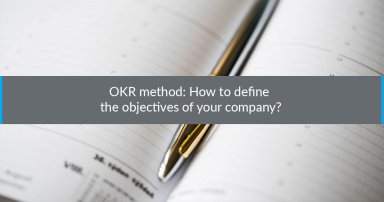
Last version published: 29/10/2020 11:49
Publication number: ELQ-26337-2
View all versions & Certificate

How to define the objectives of your company? OKR Method
A step by step process to master the OKR Method in Project Management.
Introduction
In project management as in the company in general, it is essential to set goals🎯 so that all employees can constantly move forward in the same direction. To help you, there are different methods💡.
The OKR method, used by Google in particular, makes it possible to define precise and measurable objectives📊, which are in alignment with the company's mission, and to engage employees🙋♀️.
Definition
OKR stands for Objectives and Key Results🌟. This is a management method that allows you to define and measure your objectives better📋.
The OKR method consists of setting a course, a direction to follow with the help of objectives, and measuring the progress and success of these objectives using specific indicators, the key results📈. In summary, goals tell you where to go, and key results tell you how to get there🔐.
An example of OKR:
Objective🎯:
•Improve our brand awareness
Key results🌟:
•Obtain 10 articles in leading media.
•Collaborate with 5 influencers from our industry.
•Increase the number of our followers on social networks by 100%.
The OKR method helps the company to develop a strategy and to concentrate all its efforts into achieve its vision and its missions by uniting all the employees around a common goal🛠. It is used as a way to motivate and inspire employees to achieve goals they never imagined they could achieve✨.
This method has become known due to American multinational companies such as Google, Disney, LinkedIn, Uber and Netflix. However, it can be used by companies of all sizes (including SMEs and start-ups) and from all industries.
Origin of the method
The method was invented in the 1950s by Peter Drucker, he was also nicknamed the pope of management, the OKR method was then called "Management by Objectives" or MBO🔎. It was then adopted by Andy Grove, co-founder and CEO of Intel, in the 1970s to accompany a strategic change of the company.
In 1975, John Doerr, one of Google's major investors, attended a talk given by Andy Grove at Intel, during which the OKR theory was presented. Intrigued by the method🧐, John Doerr then presented it to Larry Page and Sergey Brin who decided to apply it to Google from 1999. Today, Google still operates using the OKR method, and many other big companies have followed this method.
How does it work?
Follow these four steps to implement the OKR method in your business.
- Step n°1 |
Set an ambitious goal
To begin with, you need to define the mission of your business, department or project. Why does your business exist? What is its objective, its role? What does it bring to consumers / users?🤔
The idea of the OKR method is to set a major goal pursued by all employees🥅. This goal should describe precisely what you want to accomplish. It should be ambitious, memorable, short, motivating and engaging✨. It must be a real challenge that pushes you to surpass yourself in order to succeed.
Moreover, this may surprise and seem paradoxical, but the purpose of the method is not to achieve its objectives❗. A goal is considered accomplished when it is 60-70% achieved. If you reach 100%, your goal was too realistic and not ambitious enough.
The philosophy of the OKR method can be summed up by the quote from Oscar Wilde: "You always have to aim for the moon because even if you fail, you land in the stars🌠." - Step n°2 |
Develop a strategy to achieve your goal
Next, you need to establish a strategy to achieve your goal🥇. This strategy is broken down into intermediate objectives, key stages that must be validated as progress is made. These are called the key results🔑. These are indicators that allow you to assess your progress against the goal. For each objective, count between two and five key results. Beyond five, it becomes difficult to remember❗.
These key results should be👇:
•quantifiable and measurable to see the progress made;
•achievable to motivate teams;
•difficult to surpass themselves.
Regularly (ideally every quarter), new objectives are set based on progress📈, changes to be made or market developments. Keep in mind that these intermediate objectives must be aligned with the overall mission of the company defined upstream🧠.


